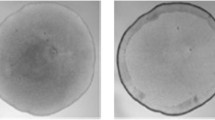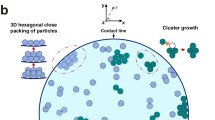Abstract
In this work, using a mathematical model and numerical simulation, we investigate the effect of time-dependent evaporation rates on stripe formation inside containers. This pattern formation is driven by the coffee-ring effect. The coffee particles inside a container move according to random walk and under the gravitational force. Because of the time-dependent evaporation rate, we can observe stripe formation inside a container after evaporation of the coffee particle-laden liquid. Various numerical experiments are performed to demonstrate the proposed model can simulate the stripe formation in a container.












Similar content being viewed by others
References
Al-Milaji, K.N., Secondo, R.R., Ng, T.N., Kinsey, N., Zhao, H.: Interfacial self-assembly of colloidal nanoparticles in dual-droplet inkjet printing. Adv. Mater. Interfaces 5, 1701561 (2018)
Deegan, R.D., Bakajin, O., Dupont, T.F., Huber, G., Nagel, S.R., Witten, T.A.: Capillary flow as the cause of ring stains from dried liquid drops. Nature 389(6653), 827–829 (1997)
Whitby, C.P., Hermant, A.: Concentration of deposit patterns by nanoparticles modified with short amphiphiles. Colloids Surf. A Physicochem. Eng. Asp. 594, 124648 (2020)
Yang, Q., Lv, C., Hao, P., He, F., Ouyang, Y., Niu, F.: Air bubble-triggered suppression of the coffee-ring effect. Colloid Interface Sci. Commun. 37, 100284 (2020)
Devineau, S., Anyfantakis, M., Marichal, L., Kiger, L., Morel, M., Rudiuk, S., Baigl, D.: Protein adsorption and reorganization on nanoparticles probed by the coffee-ring effect: application to single point mutation detection. J. Am. Chem. Soc. 138(36), 11623–11632 (2016)
Ranjbaran, M., Datta, A.K.: Retention and infiltration of bacteria on a plant leaf driven by surface water evaporation. Phys. Fluids 31(11), 112106 (2019)
Poulichet, V., Morel, M., Rudiuk, S., Baigl, D.: Liquid–liquid coffee-ring effect. J. Colloid Interface Sci. 575, 370–375 (2020)
Bridonneau, N., Mattana, G., Noel, V., Zrig, S., Carn, F.: Morphological control of linear particle deposits from the drying of inkjet-printed rivulets. J. Phys. Chem. Lett. 11(12), 4559–4563 (2020)
Morinaga, K., Oikawa, N., Kurita, R.: Emergence of different crystal morphologies using the coffee ring effect. Sci. Rep. 8(1), 1–10 (2018)
Baek, J.M., Yi, C., Rhee, J.Y.: Central spot formed in dried coffee-water-mixture droplets: inverse coffee-ring effect. Curr. Appl. Phys. 18(4), 477–483 (2018)
Lian, H., Qi, L., Luo, J., Zhang, R., Hu, K.: Uniform droplet printing of graphene micro-rings based on multiple droplets overwriting and coffee-ring effect. Appl. Surf. Sci. 499, 143826 (2020)
Zhang, D., Gao, B., Chen, Y., Liu, H.: Converting colour to length based on the coffee-ring effect for quantitative immunoassays using a ruler as readout. Lab. Chip 18(2), 271–275 (2018)
Miller, J.B., Usselman, A.C., Anthony, R.J., Kortshagen, U.R., Wagner, A.J., Denton, A.R., Hobbie, E.K.: Phase separation and the ‘coffee-ring’ effect in polymer–nanocrystal mixtures. Soft Matter 10(11), 1665–1675 (2014)
Wen, J.T., Ho, C.M., Lillehoj, P.B.: Coffee ring aptasensor for rapid protein detection. Langmuir 29(26), 8440–8446 (2013)
Mampallil, D., Eral, H.B.: A review on suppression and utilization of the coffee-ring effect. Adv. Colloid Interface Sci. 252, 38–54 (2018)
Crivoi, A., Duan, F.: Three-dimensional Monte Carlo model of the coffee-ring effect in evaporating colloidal droplets. Sci. Rep. 4, 4310 (2014)
Kim, H.S., Park, S.S., Hagelberg, F.: Computational approach to drying a nanoparticle-suspended liquid droplet. J. Nanopart. Res. 13(1), 59–68 (2011)
Crivoi, A., Duan, F.: Elimination of the coffee-ring effect by promoting particle adsorption and long-range interaction. Langmuir 29(39), 12067–12074 (2013)
Xu, T., Lam, M.L., Chen, T.H.: Discrete element model for suppression of coffee-ring effect. Sci. Rep. 7, 42817 (2017)
Yang, J., Kim, H., Lee, C., Kim, S., Wang, J., Yoon, S., Kim, J.: Phase-field modeling and computer simulation of the coffee-ring effect. Theor. Comput. Fluid. Dyn. 34(5), 679–692 (2020)
Lee, H.G., Yang, J., Kim, J.: Pinning boundary conditions for phase-field models. Commun. Nonlinear Sci. Numer. Simul. 82, 105060 (2020)
Acknowledgements
The first author (Hyundong Kim) was supported by Basic Science Research Program through the National Research Foundation of Korea (NRF) funded by the Ministry of Education (NRF-2020R1A6A3A13077105). Junxiang Yang was supported by China Scholarship Council (201908260060). Chaeyoung Lee was supported by the National Research Foundation (NRF), Korea, under project BK21 FOUR. The corresponding author (J.S. Kim) was supported by Basic Science Research Program through the National Research Foundation of Korea (NRF) funded by the Ministry of Education (NRF-2019R1A2C1003053). The authors are grateful to the reviewers whose valuable suggestions and comments significantly improved the quality of this article.
Author information
Authors and Affiliations
Corresponding author
Ethics declarations
Conflict of interest
The authors declare that there is no conflict of interests regarding the publication of this paper.
Data availability
The datasets generated during and/or analyzed during the current study are available from the corresponding author on reasonable request.
Additional information
Communicated by Peter Duck.
Publisher's Note
Springer Nature remains neutral with regard to jurisdictional claims in published maps and institutional affiliations.
Rights and permissions
About this article
Cite this article
Kim, H., Yang, J., Kim, S. et al. Numerical simulation of the coffee-ring effect inside containers with time-dependent evaporation rate. Theor. Comput. Fluid Dyn. 36, 423–433 (2022). https://doi.org/10.1007/s00162-021-00602-x
Received:
Accepted:
Published:
Issue Date:
DOI: https://doi.org/10.1007/s00162-021-00602-x




